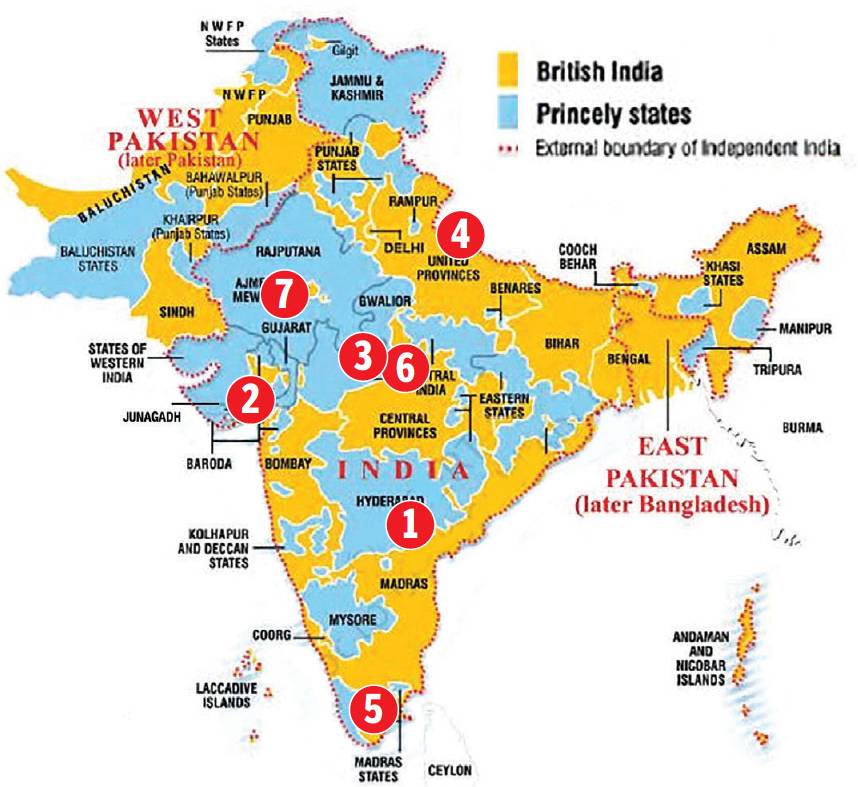The integration of Indian states
This is a collection of articles archived for the excellence of their content. Additional information may please be sent as messages to the Facebook community, Indpaedia.com. All information used will be gratefully acknowledged in your name.
This is a collection of articles archived for the excellence of their content. |
An overview
August 22, 2021: The Times of India

From: August 22, 2021: The Times of India
Under British rule, India contained more than 500 princely states that, upon Independence, had the choice of joining either India or Pakistan. But uniting the dominion was no easy task and several princely states held out for autonomy. But Sardar Patel’s special skills — of persuasion, sometimes maybe a little coercion — made them fall in line.
1 Hyderabad
After Independence, the princely state of Hyderabad decided against joining India, with the nizam preferring to remain a “sovereign state” under the British Commonwealth. Hyderabad was a key strategic state between India’s north and south, which ruled out complete autonomy as an option for the government. Hyderabad refused to sign the Instrument of Accession, the standard legal framework offered to all princely states to join India, following which it signed a ‘standstill agreement’ to maintain the status quo for a year. But Hyderabad was also seeing communal violence breakout, and was struggling to quell a communist uprising and the growing influence of an extremist Muslim militia. In September 1948, the continued instability in the state resulted in the Indian Army attacking Hyderabad as part of ‘Operation Polo’ and annexing it.
2 Junagadh
Upon Independence, the nawab of Hindumajority Junagadh opted to join Pakistan despite not sharing a border with it. The Indian government, unhappy with the accession, feared further communal violence if Junagadh was allowed to join Pakistan. To force a reversal, the government secured the accession of two of Junagadh’s vassal states, cut off supply lines to the state and surrounded it with its troops. In Bombay, a ‘provisional government of Junagadh’ was set up and led the popular agitation against the accession to Pakistan, after which the nawab fled to Karachi, allowing India to annex the state. A plebiscite was also held in February 1948, with more than 90% of the vote in favour of joining India.
3 Indore
Indore was among the few princely states that had yet to accede to India prior to August 15. But Maharaja Holkar’s acceptance came just hours after Independence — positive news for the government as Hyderabad and Junagadh resisted.
4 Oudh
Though Oudh, in present-day UP, had been annexed by the British just before the 1857 rebellion, Yusuf Mirza, the grandson of its last ruler Wajid Ali Shah, ‘assumed sovereign authority’ of the territory after a secret coronation.
5 Travancore
In 1946, the dewan of Travancore had insisted the state would remain independent after the British left but was willing to sign treaties with India and Pakistan. Some British politicians and Mohammad Ali Jinnah supported the prospect of an independent Travancore, which buoyed the dewan. But in July 1947, the dewan survived an assassination attempt by a member of the Kerala Socialist Party. The incident led to a change of heart and Travancore acceded within days.
6 Bhopal
The nawab of Bhopal, which was a Hindu-majority state, had close ties with Jinnah and saw Congress as an adversary. He feared Independence would leave Muslims ‘helpless, unorganised and unsupported’ and turn India into a communist nation, and suggested Bhopal would remain independent. But a letter from Lord Mountbatten — and seeing other princely states accede — changed the nawab’s mind. The only concession he sought was for the announcement of the accession to be delayed to 10 days after Independence.
7 Jodhpur
Jodhpur was an exception among states that had hesitated to join India — it had a Hindu ruler and a Hindu-majority population. Though the king was willing to join India, he was also negotiating terms with Pakistan in July 1947. Losing Jodhpur, a border state, would have dealt a major blow to India as it may have pushed neighbouring states towards Pakistan. But Sardar Vallabhbhai Patel intervened, offering some concessions and asking him whose side he would take in the event of communal clashes, after which the king agreed to accede.